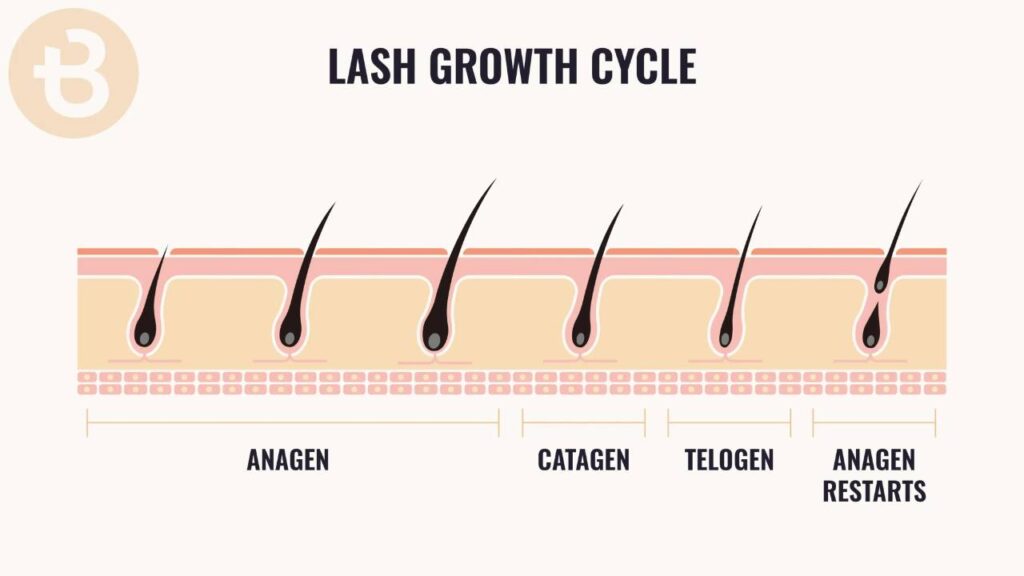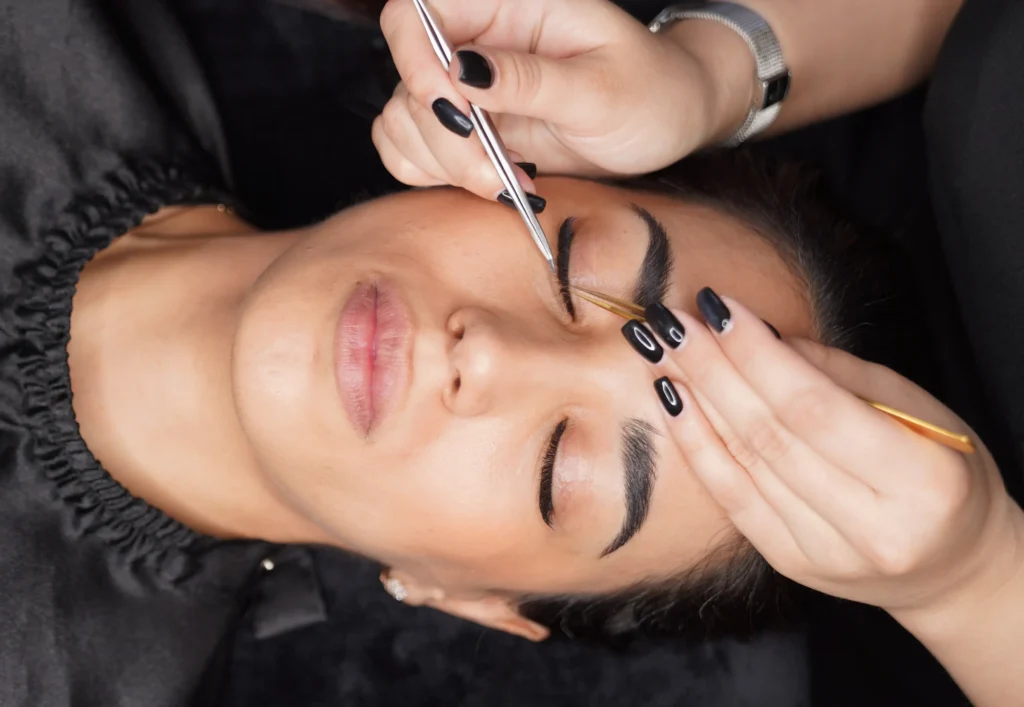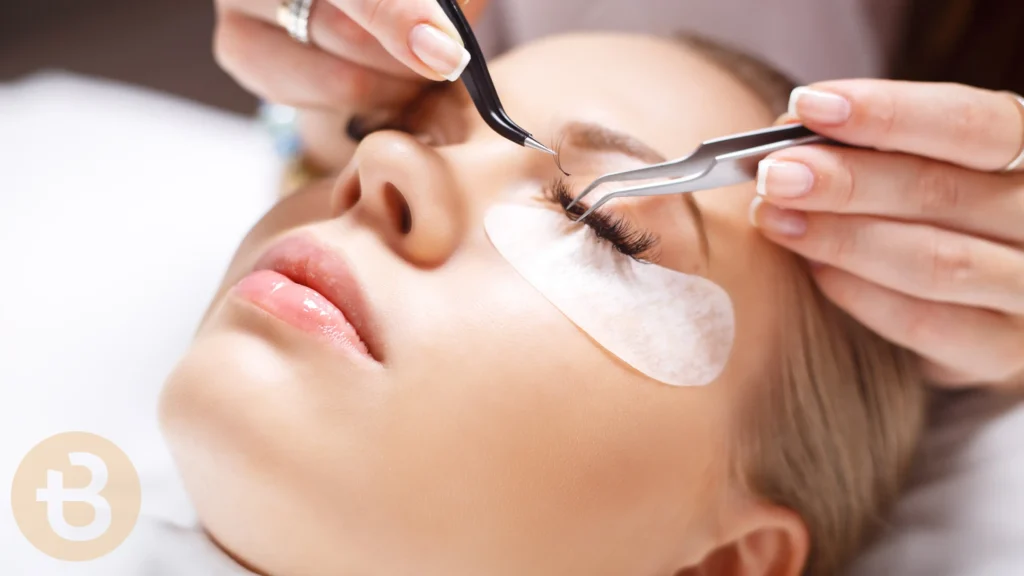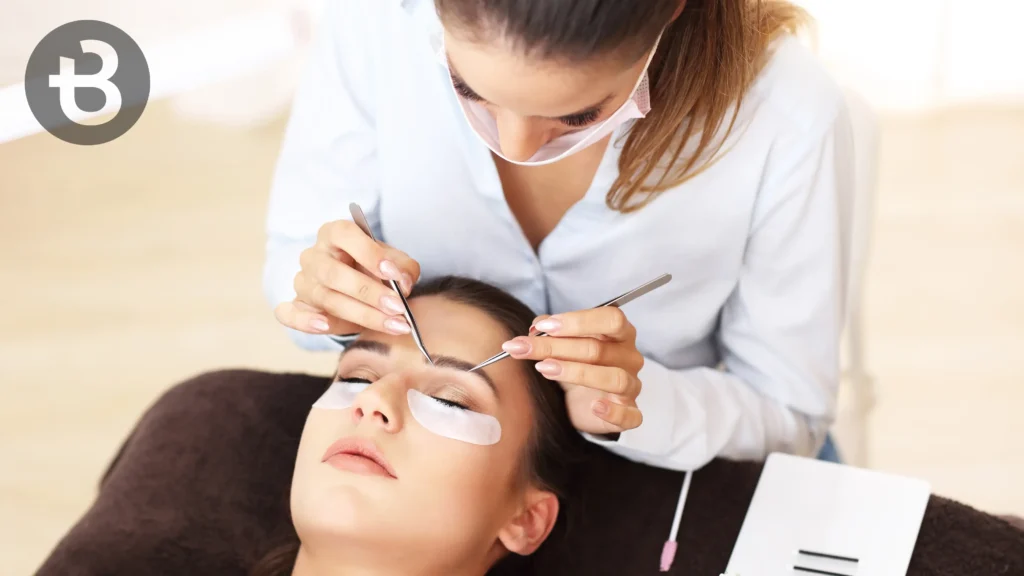
Begin by washing your face
Begin the eyelash extension removal process by thoroughly cleansing the face. A gentle cleanser should be used, focusing on removing any makeup or oils. This is crucial as any residue around the eye area can interfere with the removal process.
Special attention should be paid to the eyelashes and eyelids. All mascara must be completely removed, as its presence can complicate the effective removal of the eyelash extensions.
After cleansing, the face should be rinsed with lukewarm water. This helps to open up the pores and prepares the skin and lashes for subsequent steps.
The face should then be gently patted dry with a clean, lint-free towel, taking care to avoid rough materials around the sensitive eye area.
Apply steam to help loosen the adhesive
Steam is crucial in loosening the adhesive that binds the eyelash extensions to one’s natural lashes. To generate steam at home, one should fill a bowl with hot water.
The individual should lean over the bowl and cover their head with a towel to trap the steam, creating a sauna-like effect.
With eyes closed to prevent irritation, the steam should be allowed to work for about 10-15 minutes, gently softening the eyelash glue.
Care should be taken to ensure the steam is comfortably warm and not excessively hot, to avoid any potential burns or discomfort.
Heat some oil to dissolve the glue
Oils are effective in breaking down the adhesive used in eyelash extensions. While oil-based makeup removers are typically advised against when wearing extensions, in this instance, oil is necessary.
An individual can choose from oils like coconut, castor, olive, mineral, or baby oil. Coconut oil is particularly recommended due to its high concentration of fatty acids, especially lauric acid, which effectively binds with hair proteins.
These fatty acids enable coconut oil to penetrate the hair shaft more effectively than other oils, aiding in the breakdown of the eyelash glue.
The oil should be slightly warmed in a small bowl. The temperature must be checked to ensure it is warm, not hot, to avoid discomfort or damage to the sensitive eye area. A gentle warmth is sufficient to quicken the glue dissolution process.
Soak pads in the oil and place them on your Lashes
A lint-free cotton pad should be soaked in the warmed oil. It is important to use a lint-free pad to prevent any fibres from getting into the lashes or eyes.
The oil-soaked pad should then be gently placed on the eyelashes. The pad should cover all lashes, creating a sandwich effect for maximum contact with the adhesive.
The pad should remain on the lashes for about 5-10 minutes, or until it cools down, allowing the oil to work on the adhesive.
Alternatively, you can use a lint-free applicator to apply the oil directly to the lashes. However, pads are generally more effective and easier to handle.
During this process, it is vital to be gentle and avoid pulling on the extensions or tugging at the natural lashes, to prevent damage. The aim is for the oil to weaken the adhesive, permitting the extensions to slide off without force.
Remember, these steps are meant to provide a safer alternative to professional removal but still require patience and care. If you experience discomfort or difficulty, it’s advisable to consult a professional.
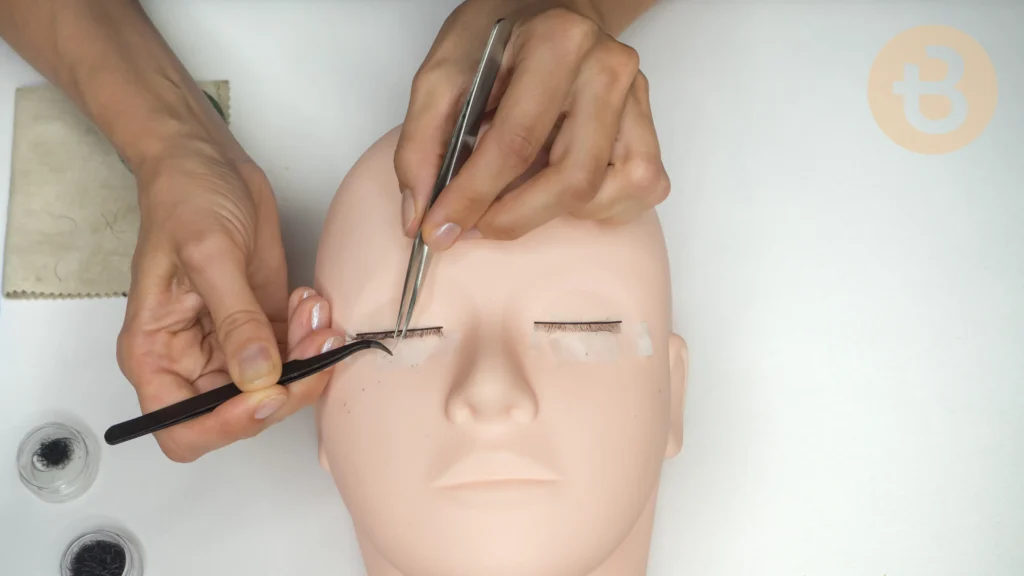
Pro Tip: Avoiding Q-tips for Eyelash Extensions
In Britain, cotton swabs are commonly referred to as “cotton buds.” It’s advisable to avoid these when dealing with eyelash extensions. The reason is that the fibres from the cotton can easily become entangled in the extensions, potentially damaging them and leading to the inadvertent removal of natural lashes.
Careful removal of Extensions
When it comes to removing eyelash extensions, utmost care is necessary. Instead of using fingers, opt for a lint-free cotton pad. This approach minimises the risk of snagging. Gently wiping downwards from the base to the tips of the lashes helps ease off the extensions without causing harm to the natural lashes.
Avoid any pulling or tugging motions, as these can harm the natural eyelashes. A gentle sweeping motion, repeated as necessary until all extensions are removed, is recommended.
If some extensions remain stubborn, reapplying oil and soaking them again is a viable option. However, should they persist, it is advised against exerting force. Under such circumstances, professional assistance is recommended for safe removal.
Alternative products and why they might not be ideal
Coconut oil is often lauded for its effectiveness in DIY eyelash extension removal, attributed to its nourishing qualities and high concentration of saturated fats, especially medium-chain fatty acids (MCFAs) such as lauric acid. These MCFAs have smaller molecular structures, which may enhance their ability to penetrate and dissolve adhesive materials.
Despite the prominence of coconut oil, other oils, products, and removers often mentioned in DIY guides on social media platforms have been explored. The aim was to assess their effectiveness and determine if they match their reputations.
Olive Oil: Although beneficial for the skin due to its high content of monounsaturated fatty acids like oleic acid, olive oil is less effective in lash removal. Its larger molecular size hampers its ability to penetrate lash adhesive efficiently. Moreover, it can leave a greasy, blurring residue in the eyes.
Castor Oil: Renowned for promoting hair growth due to its high concentration of ricinoleic acid, castor oil’s thick and sticky nature makes it less suitable for lash removal. It also does not dissolve lash glue as effectively as coconut oil.
Mineral Oil: A common ingredient in makeup removers, mineral oil is a petroleum by product that can block pores and lead to skin breakouts. It also lacks the nourishing and hydrating properties found in coconut oil.
Vaseline: As a petroleum by product, Vaseline can clog pores and cause acne. Its heavy and greasy nature makes it unsuitable for use around the eyes. Importantly, it does not act as a solvent for lash adhesive.
Baby Oil: Typically a mixture of mineral oil and fragrance, baby oil might seem gentle but falls short in breaking down lash adhesive compared to coconut oil. It also leaves a greasy residue.
Professional Lash Removers: Designed for professional use, these removers contain strong glue-dissolving agents and are hazardous if they come into contact with the eyes. They should only be used by licensed and certified lash stylists and are not suitable for DIY use.
This exploration into various alternatives reaffirms the superiority of coconut oil for DIY eyelash extension removal. Its unique properties make it the safest and most effective choice for this purpose.
Recommended products
Pura D’or Coconut Oil: This coconut oil stands out due to its cold-pressed and hexane-free qualities. It is also USDA-certified organic and is packaged in a glass bottle, which not only is more environmentally friendly but also ensures better preservation and prevents chemical leaching.
Lint-Free Cotton Pads: With a wide array of choices available, a large pack of lint-free cotton pads is highly recommended. It is important to choose lint-free options to prevent fibres from becoming entangled in lash extensions, which could potentially cause damage.

Potential risks of DIY Lash Extension removal
It’s important to be aware of the risks involved when attempting to remove lash extensions at home:
Damage to Natural Lashes: There are many instances where individuals have accidentally damaged their natural lashes during the removal process. A common error is forcefully pulling or rubbing the extensions, which not only removes the artificial lashes but can also break the natural ones. This damage can be distressing as natural lashes may take a long time, sometimes several months, to regrow to their original length and thickness. In such cases, investing in a quality lash serum could help speed up the regrowth process.
Ineffectiveness of Natural Oils: Although oils can weaken lash adhesive, most natural oils typically found in UK households are not strong enough to remove extensions in one go. The process usually requires multiple sessions, increasing the risk of damage to the lashes due to repeated handling.
Skin Issues from Excess Oil: Applying too much oil on the lash line can lead to clogged pores, which might result in blackheads, spots, and even breakouts around the sensitive eye area.
Risk of Infection or Irritation: Removing eyelash extensions on one’s own can be challenging, especially when trying to keep the eyes closed. Accidental dripping of products into the eye can lead to irritation or infection.
How Lash Technicians do It – Professional approach

Choice of Remover: Professionals often choose between gel-based and cream-based removers. The gel type, which is clear and thick, is used for targeted removal of a few extensions, while the cream type, denser in consistency, is used for full removal. The cream-based removers are generally preferred for their effectiveness.
Application Technique: The remover should be applied as close to the lash line as possible, avoiding direct skin contact. Placing a paper towel under the lashes can help keep the area clean.
Waiting Time: The remover should be allowed to sit for approximately 3 to 5 minutes.
Gentle Removal: A lint-free applicator is used to gently push the extension onto the paper towel for easy removal.
Final Clean Up: It is essential to gently wipe down the natural lashes to ensure no product residue remains.
Frequently Asked Questions
How long should I expect to spend removing Eyelash Extensions?
Typically, the process of removing eyelash extensions can take anywhere from 20 minutes to an hour. This duration depends on several factors such as the type of glue used, the number of extensions to be removed, and the method of removal. Professionals can usually do this quicker due to their expertise.
What is the quickest way to remove Eyelash Extensions?
The fastest method is often the use of a professional-grade eyelash extension glue remover. This product is designed to break down the adhesive quickly, making it easier to slide the extensions off. However, it’s crucial to use it cautiously to avoid irritation or damage to your natural lashes.
What’s the best method to dissolve Eyelash Extension glue?
The most effective method is using a glue remover specifically formulated for eyelash extensions. These removers are generally oil-based or solvent-based. They are designed to safely dissolve the glue without harming your natural lashes. Always follow the instructions carefully and consider doing a patch test to avoid any allergic reactions.
Can I remove my Lash Extensions by myself?
It is possible to remove lash extensions at home, but it requires patience and care. You can use an oil-based makeup remover or coconut oil to gently dissolve the glue. Apply the oil along the lash line and wait for a few minutes before gently wiping away the extensions. Avoid pulling or tugging on the lashes as this can cause damage. However, if you’re not confident in doing this yourself or if you encounter difficulty, it’s advisable to seek professional help.
Are you intrigued by the allure of eyelash extensions? Discover how you can become a master in this captivating field! Our comprehensive Eyelash Extension Course is tailored for both novices and seasoned practitioners, offering in-depth training in every facet of eyelash extension application. Don’t miss the chance to elevate your skills and explore new horizons in the beauty industry.


